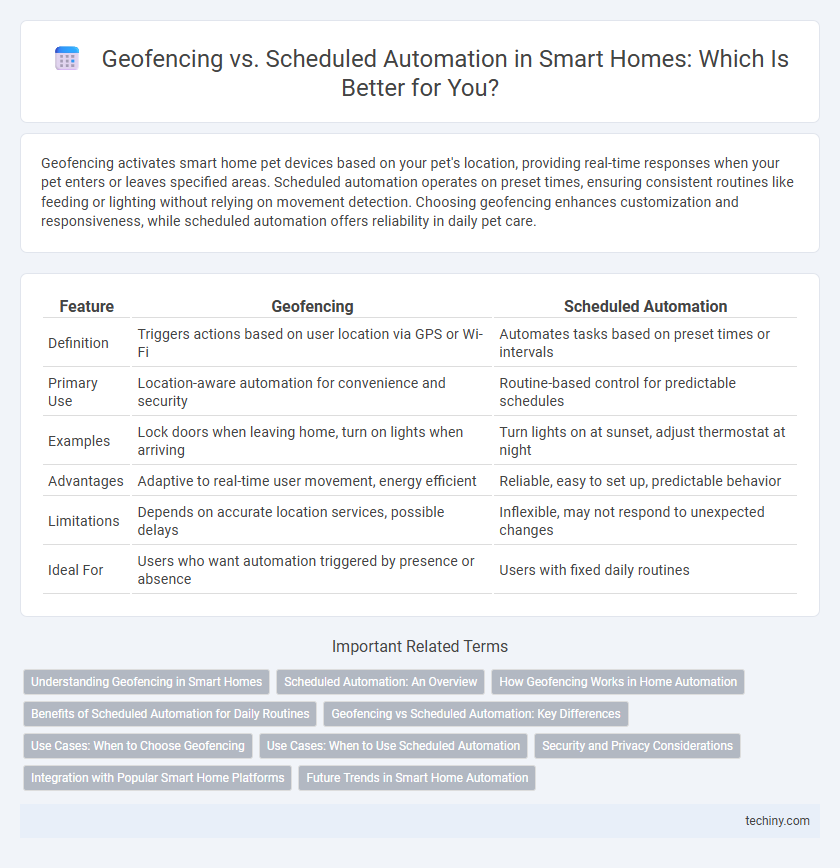Geofencing activates smart home pet devices based on your pet's location, providing real-time responses when your pet enters or leaves specified areas. Scheduled automation operates on preset times, ensuring consistent routines like feeding or lighting without relying on movement detection. Choosing geofencing enhances customization and responsiveness, while scheduled automation offers reliability in daily pet care.
Table of Comparison
| Feature | Geofencing | Scheduled Automation |
|---|---|---|
| Definition | Triggers actions based on user location via GPS or Wi-Fi | Automates tasks based on preset times or intervals |
| Primary Use | Location-aware automation for convenience and security | Routine-based control for predictable schedules |
| Examples | Lock doors when leaving home, turn on lights when arriving | Turn lights on at sunset, adjust thermostat at night |
| Advantages | Adaptive to real-time user movement, energy efficient | Reliable, easy to set up, predictable behavior |
| Limitations | Depends on accurate location services, possible delays | Inflexible, may not respond to unexpected changes |
| Ideal For | Users who want automation triggered by presence or absence | Users with fixed daily routines |
Understanding Geofencing in Smart Homes
Geofencing in smart homes uses GPS or RFID technology to create virtual boundaries, triggering automation when residents enter or leave designated areas. This location-based control allows for dynamic adjustments like turning lights off when leaving or adjusting thermostats upon arrival, enhancing energy efficiency and convenience. Unlike scheduled automation, which relies on fixed times, geofencing reacts to actual presence, providing personalized and context-aware smart home management.
Scheduled Automation: An Overview
Scheduled automation in smart home systems allows users to predefine specific times for devices and routines to activate or deactivate, enhancing energy efficiency and convenience. This method relies on fixed schedules rather than location data, ensuring consistent operation regardless of the homeowner's presence. By using scheduled automation, homeowners can optimize lighting, climate control, and security systems to align with daily habits and preferences.
How Geofencing Works in Home Automation
Geofencing in home automation uses GPS or RFID technology to create virtual boundaries around a specific location, triggering devices as users enter or leave these zones. When a homeowner's smartphone crosses the geofence perimeter, connected systems automatically adjust settings like lighting, thermostat, and security alarms based on predefined preferences. This real-time location-based control offers personalized convenience and energy efficiency compared to traditional scheduled automation that operates on fixed time intervals.
Benefits of Scheduled Automation for Daily Routines
Scheduled automation enables precise control of smart home devices by activating them at predetermined times, ensuring consistent energy savings and enhancing convenience. It optimizes daily routines by automating lighting, heating, and security systems without relying on location data, providing reliable performance regardless of user presence. This approach minimizes user intervention and supports seamless integration with other smart home functionalities for a streamlined lifestyle.
Geofencing vs Scheduled Automation: Key Differences
Geofencing automation triggers smart home devices based on a user's real-time location using GPS or RFID technology, enabling actions like turning lights off when leaving home or adjusting thermostats upon arrival. Scheduled automation operates on predefined time settings, activating devices at specific hours regardless of presence or location. The key difference lies in geofencing's responsiveness to spatial movement versus scheduled automation's reliance on fixed temporal patterns.
Use Cases: When to Choose Geofencing
Geofencing triggers smart home devices based on a user's real-time location, making it ideal for scenarios like turning off lights and adjusting thermostats automatically when leaving home or unlocking doors upon arrival. This location-based automation enhances security and convenience by responding instantly to changes in proximity without requiring manual input. Geofencing is preferred over scheduled automation when users have irregular routines or need responsive control tied directly to their presence.
Use Cases: When to Use Scheduled Automation
Scheduled automation is ideal for predictable routines such as daily lighting changes, thermostat adjustments, or irrigation schedules, ensuring consistent energy savings and convenience without reliance on location data. It excels in environments where user presence is stable, like waking up at the same time every day or turning off devices during set hours. This method avoids potential inaccuracies of geofencing and maintains control even when GPS signals are weak or mobile devices are inactive.
Security and Privacy Considerations
Geofencing enhances smart home security by triggering actions based on an occupant's real-time location, minimizing unauthorized access through automatic locking and alert systems. Scheduled automation operates on predefined times, reducing the risk of location tracking but potentially introducing vulnerabilities if schedules are predictable or compromised. Balancing these approaches requires robust encryption and strict data access controls to safeguard user privacy and prevent exploitation by malicious actors.
Integration with Popular Smart Home Platforms
Geofencing integrates seamlessly with popular smart home platforms like Amazon Alexa, Google Home, and Apple HomeKit, enabling location-based triggers that enhance automation precision. Scheduled automation also supports these platforms, allowing users to set specific times for device control, but lacks dynamic responsiveness to user presence. Combining geofencing with scheduled automation maximizes smart home efficiency by leveraging platform-specific APIs for both time-based and location-based control.
Future Trends in Smart Home Automation
Geofencing technology in smart homes uses real-time location data to automate tasks based on user proximity, offering dynamic and personalized control compared to traditional scheduled automation which relies on fixed time settings. Future trends indicate a shift towards hybrid systems that integrate AI-driven geofencing with predictive scheduling to enhance energy efficiency, security, and user convenience. Advanced machine learning algorithms will enable smart homes to adapt autonomously by analyzing patterns in occupant behavior and environmental conditions.
Geofencing vs Scheduled Automation Infographic

 techiny.com
techiny.com